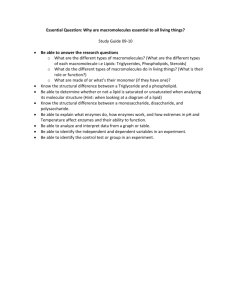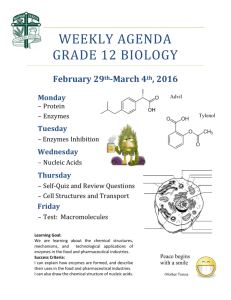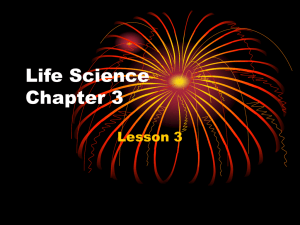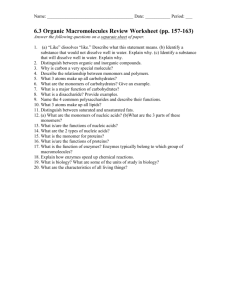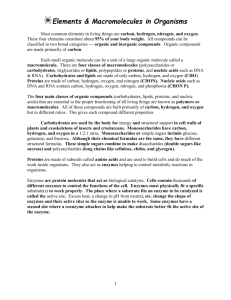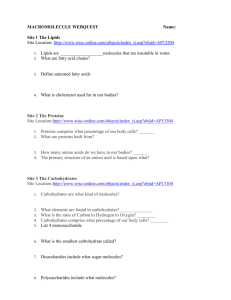Biological macromolecules 5E LesSon
advertisement
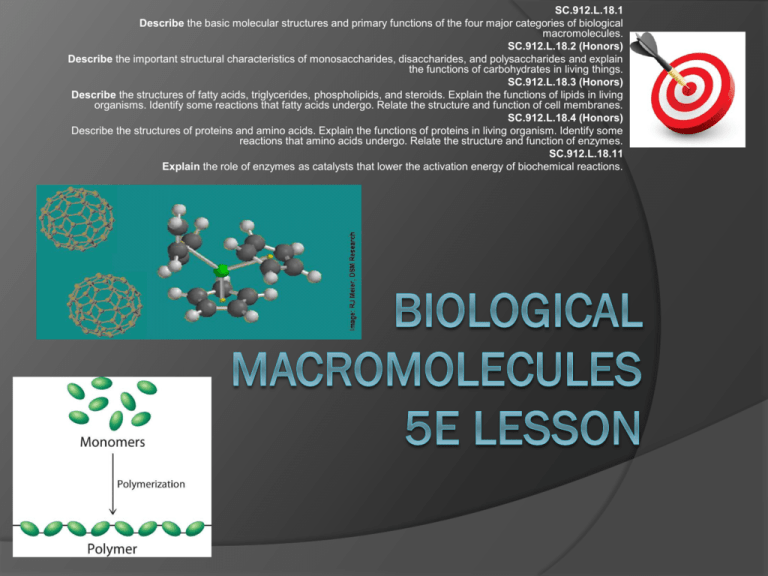
SC.912.L.18.1 Describe the basic molecular structures and primary functions of the four major categories of biological macromolecules. SC.912.L.18.2 (Honors) Describe the important structural characteristics of monosaccharides, disaccharides, and polysaccharides and explain the functions of carbohydrates in living things. SC.912.L.18.3 (Honors) Describe the structures of fatty acids, triglycerides, phospholipids, and steroids. Explain the functions of lipids in living organisms. Identify some reactions that fatty acids undergo. Relate the structure and function of cell membranes. SC.912.L.18.4 (Honors) Describe the structures of proteins and amino acids. Explain the functions of proteins in living organism. Identify some reactions that amino acids undergo. Relate the structure and function of enzymes. SC.912.L.18.11 Explain the role of enzymes as catalysts that lower the activation energy of biochemical reactions. Guiding Questions How are structure and function of the major biomolecules related? How do enzymes impact chemical reactions in an organism? ENGAGE – On a notecard… 1) 2) 3) 4) Write down everything that you have consumed today. (If you have not eaten anything, write down what you had for dinner last night) Share your response with your shoulder partner and discuss the importance of eating. Attempt to identify the foods that are mostly carbohydrates (carbs), lipids (fats), and proteins. KEEP YOUR NOTECARD!!! EXPLORE – Video EXPLORE – Card Sorting You should have 4 Yellow cards: Carbohydrates Lipids Nucleic Acids Proteins You should have several food cards Lay out your 4 yellow cards Sort each food into the 4 yellow groups EXPLAIN – Prezi <iframe width="550" height="400" id="iframe_container" src="https://prezi.com/embed/vj5ee96ce6p 0/?bgcolor=ffffff&amp;lock_to_path=0&amp ;autoplay=0&amp;autohide_ctrls=0&amp;la nding_data=bHVZS2czc0xFVDVJVDdxaT R3NTg3ajBmRDdRVnpQeWI&amp;landing _sign=VyJIyw0NdzELiVJwJeFmds1Hn6OV YES5zEe-kW4vG7A" frameborder="0" allowfullscreen="" webkitAllowFullScreen="" mozAllowFullscreen=""></iframe> Organic Chemistry The study of carbon-containing compounds. CARBON (pg. 45) 1. 4 valence electrons Carbon can bond with many elements, including hydrogen (H), oxygen (O), phosphorus (P), sulfur (S), and nitrogen (N) to form molecules of life. 2. One carbon atom can bond to another carbon atom Gives carbon the ability to form chains o Single, double, or triple covalent chains May form rings Single, Double, Triple Covalent Bonds Macromolecules (Pg. 46) “giant molecules” o “macro”= giant Made from thousands or even hundreds of thousands of smaller molecules. Formed through “polymerization” o Large compounds (polymers) are built by joining smaller ones (monomers) together. 4 Groups of Macromolecules (Pgs. 46-49) Carbohydrates Nucleic Acids RNA Simple sugars DNA Complex carbs Lipids (fats) Saturated Unsaturated Protein Guiding Question How are structure and function of the major biomolecules related? EXPLAIN – Book Take out your 4 Biological Macromolecules Book Complete the “F” or “Function” pages of each macromolecule by explaining: Definition Primary job/function (How does it work?) Nutritional importance EVALUATE – On a notecard… Refer back to your notecard… Attempt to individually categorize your meal items based on the four groups of macromolecules. Guiding Question How do enzymes impact chemical reactions in an organism? Chemical Reaction pg. 50 A process that changes, or transforms, one set of chemicals into another. Energy and mass are conserved during chemical transformations (Law of Conservation of Energy) Involves changes in chemical bonds that join atoms in compounds. Breaking old bonds to create new bonds Necessary for organism to maintain all characteristics of life Requires reactants to produce product(s). Reactants and Products The elements or compounds that enter into a chemical reaction are known as reactants. The elements or compounds that are produced by a chemical reaction are known as products. Chemical reactions that are going on in your body at this moment: Metabolism: Sum of all of the chemical reactions that take place within living cells, by which complex molecules are broken down to produce energy and by which energy is used to build up complex molecules. Digestion Absorption Cellular respiration Etc… Chemical Reactions and Energy Energy is released or absorbed whenever chemical bonds are formed or broken. Chemical reactions that release energy often occur on their own (spontaneously) but not always. Therefore, chemical reactions also involve changes in energy. (pg. 51) (Ex. Cellular Respiration and digestion) Chemical reactions that absorb energy will not occur without a source of energy. (Ex. Photosynthesis) Main Sources of Energy SUNLIGHT (plants) Eating (animals eat plants and/or other animals) How do we get a reaction started? ACTIVATION ENERGY = The energy that is needed to start a reaction. Guiding Question How do enzymes impact chemical reactions in an organism? Is it possible to speed up the rate of a chemical reaction? YES!!! Enzymes: Also known as “nature’s catalysts”, are proteins that speed up the rate of chemical reactions by lowering the activation energy (pg. 52). Enzyme-Substrate Complex (pg. 52) Regulation of Enzyme Activity (pg. 53) Temperature, pH, and regulatory molecules can affect the activity of enzymes. Enzymes produced by human cells generally function best at temperatures close to 37°C (normal temperature of human body) Enzymes work best at certain ionic conditions and pH values. Example: Pepsin (stomach enzyme) works best under acidic conditions. Protein Denaturation So what happens to enzymes once the chemical reaction has occurred? The enzyme “resets” itself to be used again. So what will you take into the world today? Write at least one paragraph that summarizes this lesson on biological macromolecules. Use relevant vocabulary terms (used correctly), interesting facts, and information about the four major groups of macromolecules and enzymes. Please include any question that you may still have pertaining to this lesson. Notice: We will have a lab next class! Be sure to have your lab safety contracts turned in and wear closed-toe shoes!!! ELABORATE – Lab Fat Test Heavy cream Peanut butter Egg whites Egg yolks Yogurt Water Starch Flour Potato Sugar Bread Water Test
